In the realm of design, the delicate balance between aesthetics and functionality shapes our surroundings, from the cosy corners of homes to the sprawling spaces of commercial projects. Rooshad Shroff, an accomplished architect/designer with a keen eye for detail, offers us a glimpse into his approach to crafting these diverse environments. With a strong foundation in design, including studies at Cornell University and Harvard University, and a commitment to both tradition and innovation, Rooshad has established himself as a prominent figure in the industry. Having also had the privilege of working with renowned architect Zaha Hadid, his experiences have further enriched his creative journey. In this interview, we delve into his perspectives on navigating the intersection of traditional craftsmanship and modern design, the art of collaboration, staying inspired, and the evolving role of technology in shaping our living spaces.
FOYER: I have read a little about you and have also seen some of your work. How did you first become interested in architecture? Was it influenced by your family’s involvement in architecture, or did you independently develop an interest in it? Can you tell us about the moment when you realised that architecture was what you wanted to do?
Rooshad Shroff: Absolutely. You know, from a young age, I was exposed to the world of architecture through my father’s work. I used to visit his office and even accompany him to construction sites. Interestingly, while my parents encouraged my brother and me to explore different paths outside of architecture, my exposure to the field was quite significant. Even when we travelled, we would often come across remarkable buildings and museums that piqued my interest in art and design. So, my journey into the world of design was sort of organic, more like a subconscious initiation.
It’s worth noting that I wasn’t explicitly told to become an architect – it was the opposite. Despite that, my fascination with design and the world around me continued to grow. I was drawn to the creative aspects of architecture, and this interest started shaping up as I grew up. Eventually, it became clear to me that I wanted to pursue something in the realm of design. As I considered my options, architecture naturally emerged as the perfect blend of creativity, art, and practicality. It was more of a gradual realisation rather than a conscious decision I had to make. The interest was always there, guiding me toward this path, and it felt like the most natural step as I entered school.
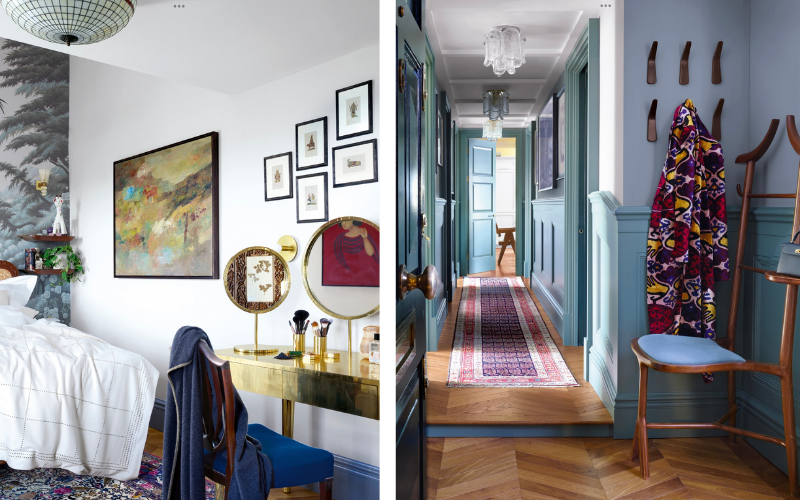
F: I’ve noticed that you have a very distinct and unique style in your work. Can you tell us how you developed your own personal aesthetic and design philosophy, especially in terms of contemporizing Indian craftsmanship? How did you decide to take this route and create a style that stands out?
RS: Certainly. My journey into developing my style wasn’t a deliberate decision, but rather a gradual evolution. After studying and working abroad for about a decade, I returned to India. Initially, it wasn’t a planned move, but circumstances led me to stay in Bombay longer than expected. During that period, I had the luxury of time, as some projects came and went. This time allowed me to explore various avenues, including designing furniture.
Furniture design was something I had a keen interest in, especially on a smaller scale. I began experimenting with different materials, and I remember one of my first chair designs was made from metal. Interestingly, finding someone willing to manufacture a one-off metal piece proved challenging due to the industry’s preference for mass production. This led me to collaborate with a traditional carpenter who was open to crafting unique pieces. This experience introduced me to the beauty of handmade craftsmanship, and my appreciation for the handmade process began to grow. Initially, I wasn’t actively seeking to incorporate craft into my work. I was somewhat hesitant due to my perception that craft could be overly ornamental or decorative. However, as I delved into different materials and techniques, I started to understand the depth and potential of traditional crafts. It struck me that craft could add a layer of detail and sophistication that might otherwise be inaccessible in contemporary design.
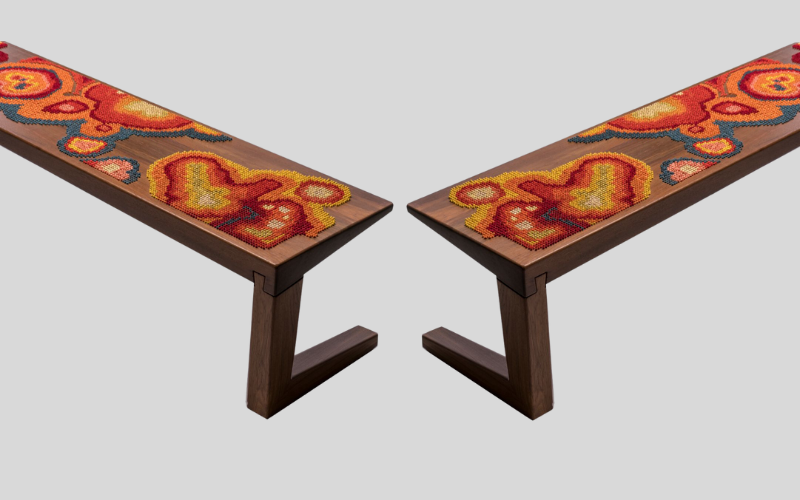
This realisation was underscored by my exposure to a global design scene where trends seemed to converge, lacking distinct cultural references. This observation drove me to explore India’s rich craft heritage as a way to infuse authenticity and uniqueness into my designs. I saw craft as a means of giving a sense of place and authorship to my work, something that was missing in the sea of similar designs. As I explored and experimented with craft in furniture, it became a testing ground for research and innovation. This experimentation naturally extended to interior projects, where I found ways to incorporate craft into various elements. The idea of customization, celebrating craftsmanship, and creating bespoke designs became consistent threads in my work.
People often ask me about my style, and while I struggle to define it succinctly, I can say that my work consistently revolves around celebrating craft, embracing the essence of the handmade, and infusing a sense of place into every design. Craftsmanship has become an integral part of my design philosophy, adding depth, authenticity, and a connection to heritage in a contemporary context. I believe I’ve only scratched the surface of what craft can bring to the world of design, and I continue to explore its possibilities and potential.
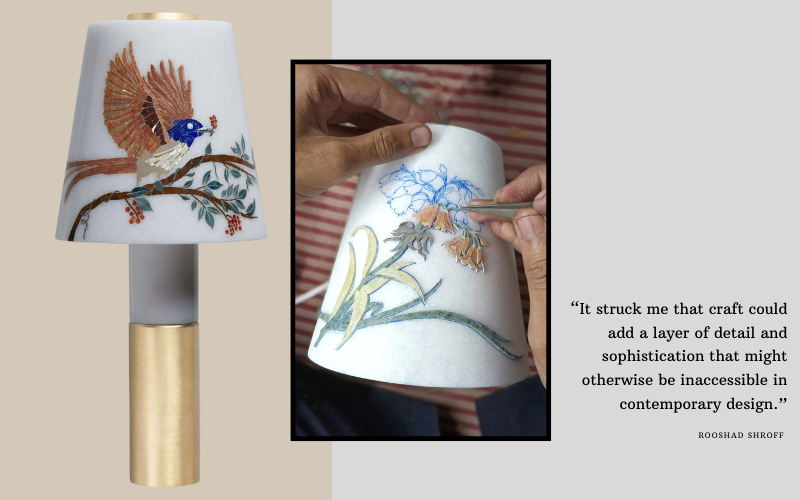
F: Your journey of appreciating Indian craftsmanship despite initial aversion resonates with my own experience. Having lived abroad and studied there, I, too, grew to value the intricacies of Indian craftsmanship more over time. It’s true, the level of detailing and artistry you get here is often unparalleled.
RS: Absolutely, it’s a transformative process that many of us go through as we gain a deeper understanding of the value and uniqueness that Indian craftsmanship brings.
F: Rooshad, your work spans various creative realms such as design, architecture, interiors, art, and even visual merchandising. How do you manage to navigate these diverse areas while maintaining your creative edge? Is there a distinct approach for each domain, or do you follow a unified process across all of them?
RS: Each creative domain requires a slightly different approach, as you can see from our portfolio, where we strive to create distinct designs that don’t adhere to a single prescribed style. It all begins with understanding the project’s brief and finding practical and innovative solutions. A key element is the conceptual phase, questioning the brief and challenging ourselves to find creative solutions. This process applies to all areas of our work, whether it’s architecture, interior design, or creating unique art installations.
Our creative process remains consistent in terms of the iterative nature of design. There’s a lot of exploration, prototyping, and research involved. Even when it comes to selecting materials, we thoroughly research different techniques and craft possibilities. We don’t just sketch something and then look for a vendor; rather, the design process is intertwined with material research and development.
Diversity in project types and scales is something I cherish. I believe that experiencing design at various scales is essential to honing one’s design sensibilities. The design approach for a piece of furniture might be different from that of an architecture project or a visual merchandising installation. I find working on various scales and types of projects enriching, allowing me to explore design from multiple angles.
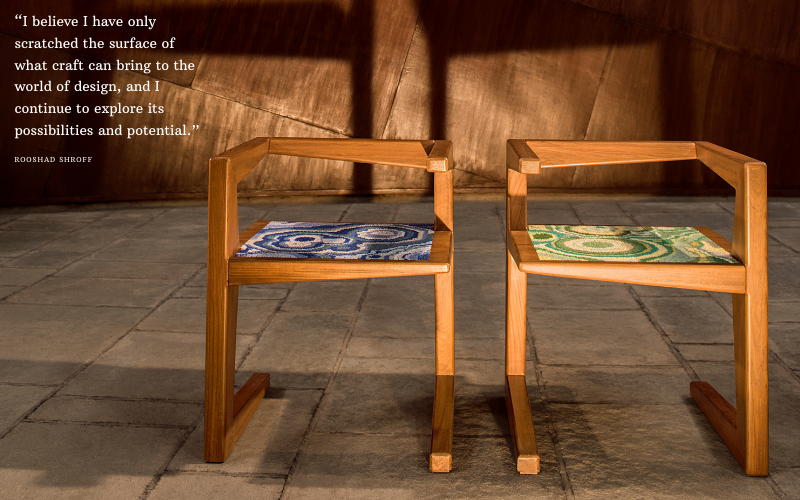
F: Your ability to adapt your approach while maintaining a consistent commitment to the creative process is commendable. I noticed your collaboration with the CSMVS Museum and the Museum on Wheels initiative. Can you shed some light on that project and your role in it?
RS: Certainly. The Museum on Wheels initiative by the CSMVS Museum is an incredible initiative that brings the museum experience to underprivileged and remote schools that lack access to such cultural resources. Citibank sponsored this initiative to create a mobile museum that could reach schools where students might not have the opportunity to visit a museum. My involvement in this project revolved around designing and overseeing the creation of the mobile museum. The challenge was to design a compact space that catered to the ergonomic needs of children and was flexible enough to accommodate different types of exhibitions. It needed to be robust for travelling while being engaging and educational for the children.
The initiative is ongoing, and the themes change every six months, offering a diverse range of educational experiences. It’s an incredible way to expose young minds to various subjects and ignite their curiosity. My contribution to this project was motivated by a desire to give back to education and contribute to something that truly matters.
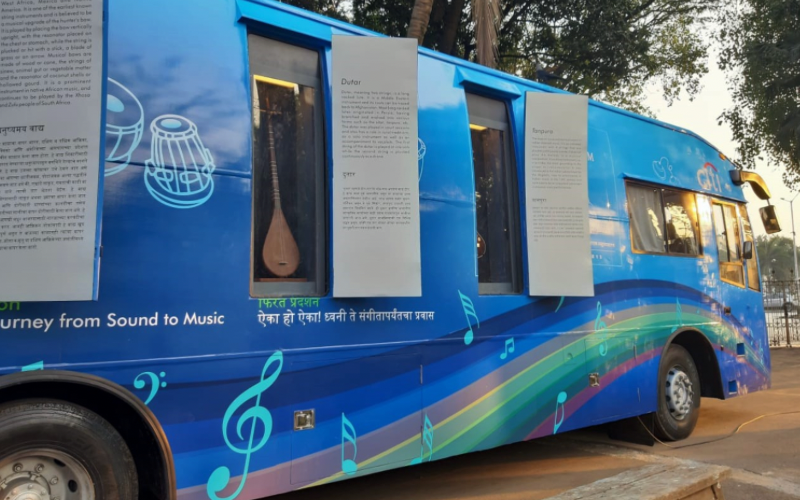
F: It’s truly inspiring to see how you’re using your creative talents to contribute to education and make a positive impact on young minds. Your dedication to diverse projects and your passion for bringing creativity to various domains is remarkable, Rooshad.
Is the Museum on Wheels initiative only running in Maharashtra or is it in other places as well?
RS: It’s only in Maharashtra due to the funding and the focus on reaching out to schools in that region.
F: Understandable, Maharashtra is quite extensive itself.
F: When collaborating with traditional artisans and craftsmen, have you encountered challenges in terms of quality and meeting your expectations?
RS: Quality is indeed a concern and it’s an ongoing challenge. Even when working with the same artisans for years, without consistent quality checks, they can fall into comfort zones. However, a significant challenge early on was changing the artisans’ mindset. For example, with marble artisans, my initial designs were met with resistance. They hesitated to work on clean and minimal designs due to the fear of failure. They were paid per piece, and venturing beyond their comfort zone could result in wasted time and materials. To address this, I restructured payment to include research and development even if things went wrong. This approach fostered a more open mindset and willingness to experiment, leading to exciting results.
F: It’s impressive how you’ve fostered collaboration and encouraged artisans to explore new avenues by supporting their efforts. Now, you’ve worked with established brands like Christian Louboutin and Sonam Kapoor. How do you maintain your unique style when collaborating with brands that already have strong identities?
RS: Our approach revolves around understanding the brief deeply and adapting our distinctive way of working to enhance their brand. We don’t have a single prescribed style, but we follow a specific method. It’s like taking their brand DNA and adding layers that they might not currently have. We provide a bespoke service, ensuring every aspect is designed and created by us rather than relying on styling. I focus on individualised customization, which often takes longer but leads to unique outcomes.

F: That’s a thoughtful approach, tailoring your process to enhance each brand’s identity. Now, let’s discuss your sources of inspiration. How do you stay creatively inspired? Are there specific influences, experiences, or places that shape your design sensibilities?
RS: Inspiration comes from diverse sources. Art, both contemporary and historical, is a significant influence. History and research play a role as well, providing insights into design evolution. Travel is a great source, exposing me to exhibitions, shows, and museums not readily available locally. I make an effort to visit as many exhibitions and museums as possible, even during work trips, as it exposes me to new ideas. Instagram also offers inspiration and connection within the design community. Ultimately, inspiration can come from anywhere—a random drive, a movie, or even something I’ve seen for years that suddenly resonates with a current project.
F: Let’s now delve into your perspective on the future of design in India, particularly in terms of preserving traditional craftsmanship while embracing innovation and modernity.
RS: Well, honestly, I’m not one to proclaim a grand vision for design in India. My focus lies more within our realm of work. My goal is to establish a brand that takes Indian craftsmanship to a higher level in the design world. There’s sometimes a tendency to use terms like “handmade” and “craft” loosely, even as an excuse for subpar workmanship. Take, for example, brands like Hermes – they produce stunning pieces that stand on their own, irrespective of the handmade aspect. I hope to see Indian brands that adopt a similar approach, creating products that possess international standards of quality and design.
F: It’s great to hear your perspective on elevating craftsmanship and quality in the Indian design landscape. Moving on to collaborations, they seem to be a significant part of your work. How do these collaborations enrich your projects, and what do you seek in potential partners?
RS: Absolutely, collaborations have become more selective for me. I look for collaborations where there’s an opportunity to learn and grow. When I collaborate, I want to gain insights and experiences that I might not have encountered otherwise. Take the Gyaan project, for instance. I collaborated with different artists, architects, and designers to create marble plates that were sold to fund a girls’ school in Jaipur. This collaboration was meaningful because it involved learning from each participant’s creative vision, adapting it to the medium, and working together to achieve a shared goal. It’s about creating something together, not just one party shouldering the work.
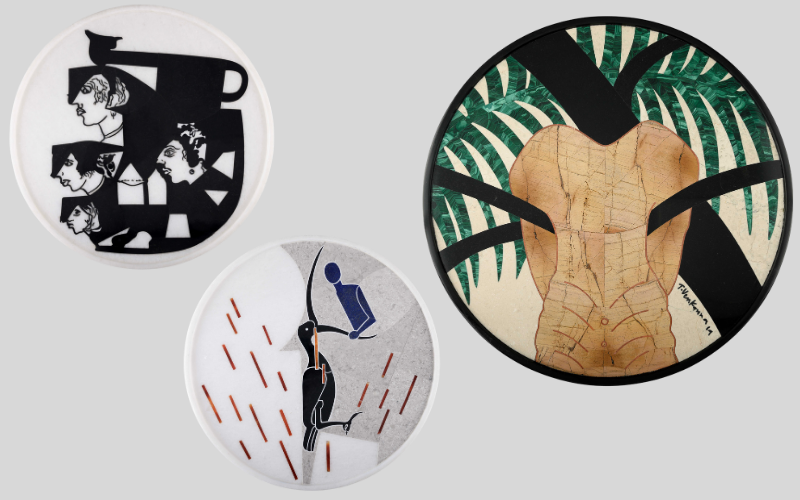
F: That’s an insightful approach to collaborations, emphasising mutual learning and contribution. Shifting to the role of technology, how do you see technology influencing the design process, and how do you incorporate it into your work?
RS: Technology is an integral part of design. We use software and even 3D printers to aid our work. These tools help us visualize and communicate designs more effectively. For instance, we might use 3D printers to create prototypes that artisans can better understand, especially when they might not be well-versed in reading traditional drawings. Technology also helps us evolve our designs, offering new perspectives and possibilities.
F: Balancing aesthetics and functionality can be quite a challenge in design. Could you share your approach to striking this balance between the allure of aesthetics and the practicality of functionality?
RS: Functionality does not always take precedence. I don’t focus on aesthetics either. The focus here while approaching a piece or a craft is to push the boundaries of making and the material being used. It is to understand the know-how and see how we can cleverly re-adapt the know-how in a unique way.
F: Let’s talk about the process of designing for different contexts. For instance, when you’re creating a home, comfort and personal expression are key factors. How does your approach differ when designing for residential spaces compared to commercial projects?
RS: Absolutely, the approach varies significantly based on the context. When it comes to designing a home, the focus is on creating a comfortable and personalized space. The design approach is guided by the homeowner’s needs and lifestyle. For instance, if it’s a space meant for entertainment, the furniture choices might differ from a space designed for relaxation and cosiness. On the other hand, when dealing with commercial projects, such as offices or public spaces, different considerations come into play. It’s about understanding the purpose of the space and tailoring the design to accommodate those requirements.
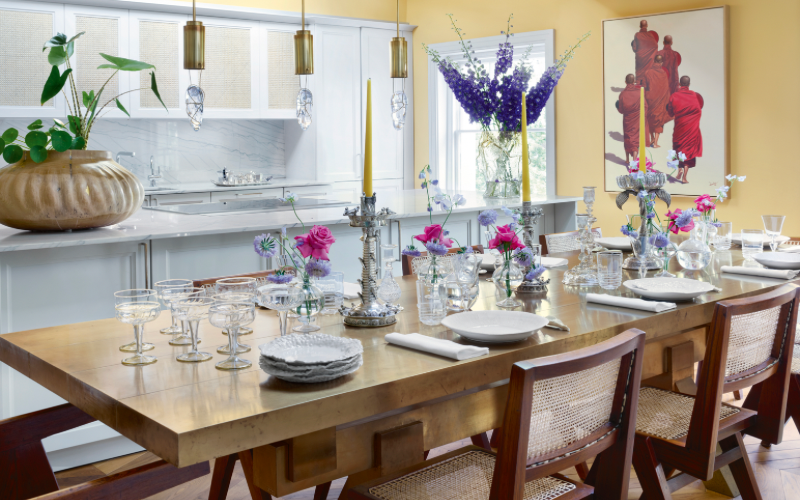
F: Indeed, the approach to residential and commercial projects is distinct, with different priorities to address. Shifting gears, and staying updated with the latest trends, technology, and materials is crucial in the design field. How do you manage to stay informed and engaged with these developments while being based in India?
RS: Staying in tune with the ever-evolving design landscape is an ongoing effort. While it’s impossible to know everything, curiosity is a driving force for me. I make an effort to explore new things, even through casual activities like scrolling through my phone, reading design magazines, and researching during traffic jams. Attending design fairs is another significant way to keep up. Fairs like ACETECH or international events like Salone offer a condensed showcase of the latest materials and technologies. I find events like Salone particularly exciting due to the immersive experiences and installations that accompany the products. Encouraging my team to actively seek out new ideas and experiences also contributes to our collective awareness.
F: Thank you for sharing your insights into staying current within the design world. Your approach to attending fairs and seeking firsthand experiences is valuable. Thank you so much for your time, Rooshad.
RS: My pleasure. It’s been great discussing these aspects. Thank you.
Rooshad Shroff’s design journey showcases a deep appreciation for the intricate relationship between form and function. His ability to seamlessly merge traditional craftsmanship with contemporary design principles breathes life into spaces that exude both beauty and purpose. As he continues to explore the delicate dance between the past and the present, Rooshad’s insights inspire us to rethink the boundaries of design, collaborate creatively, and keep our fingers on the pulse of innovation. With his vision and commitment, the future of design in India holds the promise of a harmonious blend of heritage, innovation, and limitless creativity.
Images via Rooshad Shroff


